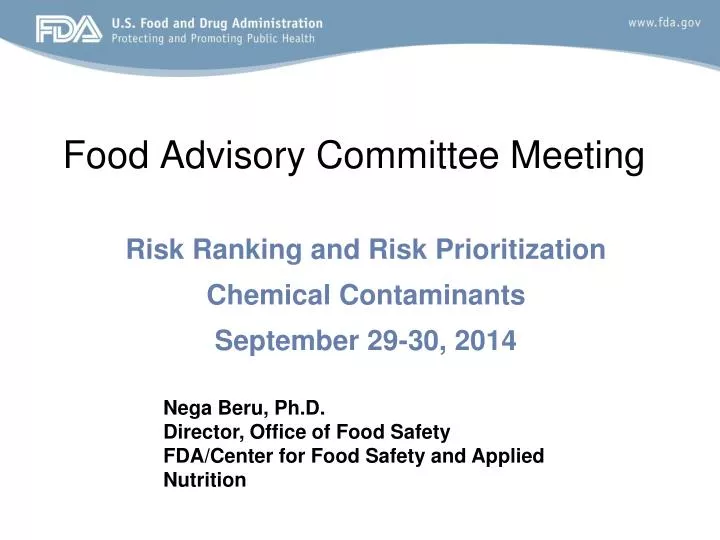Report on the Expanded Decision Tree (EDT) and its Alignment with Sustainable Development Goals
This report details the U.S. Food and Drug Administration’s (FDA) Expanded Decision Tree (EDT), a modernized scientific tool for assessing the toxic potential of chemicals in the food supply. The development and application of the EDT are analyzed in the context of its significant contributions to achieving the United Nations Sustainable Development Goals (SDGs), particularly those concerning public health, innovation, and responsible production.
Advancing Global Health and Food Safety through Scientific Innovation
The presence of unevaluated or improperly managed chemicals in food poses a direct risk to human health, undermining progress towards SDG 3: Good Health and Well-being. The FDA’s mandate to safeguard the food supply involves the rigorous evaluation of food ingredients, food contact substances, and chemical contaminants. The EDT represents a New Approach Method (NAM) that enhances the FDA’s capacity to protect public health by providing a rapid, data-driven screening mechanism for chemical toxicity.
As an evolution of the original Cramer Decision Tree, the EDT utilizes a refined, structure-based classification system to deliver more precise estimations of a chemical’s toxic potential. This innovation is critical for managing the vast landscape of chemicals present in the modern food supply and supports the global goal of ensuring safe and nutritious food for all.
Development of the Expanded Decision Tree: A Collaborative and Data-Driven Approach
Rationale for Development in Support of SDG 3
The FDA faces the continuous challenge of evaluating hundreds of chemical submissions annually and prioritizing emerging chemical concerns. The EDT was developed to address this challenge, providing a systematic support tool for predictive toxicity. This directly supports SDG 3 (Good Health and Well-being) by enabling more efficient and targeted safety evaluations to protect consumers from harmful substances.
When assessing a substance, the FDA considers the following key factors:
- Safety data and calculated exposure levels.
- The chemical identity and structure, including similarities to known substances.
- Anticipated human exposure based on the substance’s intended use and concentration in food.
Foundational Data and Multi-Stakeholder Collaboration
The strength of the EDT lies in its comprehensive toxicology database, which is foundational to its predictive power. This aligns with SDG 12: Responsible Consumption and Production, by promoting the sound management of chemicals. The database includes:
- Data from the Munro database as a starting point.
- Toxicological, metabolic, and chemical data from authoritative international bodies such as the FAO/WHO Expert Committee on Food Additives, the U.S. EPA, and the European Food Safety Authority (EFSA).
- Information on chemicals from food additives, GRAS substances, food contact substances, and NTP study reports.
The development process exemplifies SDG 17: Partnerships for the Goals. The FDA engaged a broad spectrum of stakeholders, including experts from EFSA, the U.S. EPA, various universities, and the NIH’s National Toxicology Program, ensuring the tool is robust, scientifically validated, and internationally recognized.
Methodology and Application of the EDT
Screening Chemicals to Protect Public Health
The EDT functions as an open-source tool that sorts chemicals into classes of estimated toxicity based on a series of structure-based questions. This process fosters transparency and collaboration, allowing regulators and industry to advance food chemical safety in unison. The EDT is designed to predict the chronic oral toxicity of organic compounds, though it does not apply to inorganic elements, non-hydrolyzable polymers, or nanomaterials. It serves as a support tool and does not replace statutory pre-market authorization processes.
Tiers of Toxicity and Contribution to Responsible Science (SDG 12)
The EDT classifies chemicals into a refined set of toxicity classes, providing a predicted Threshold of Toxicological Concern (TTC) level. This detailed classification allows for a more nuanced risk assessment. A key contribution of this methodology is its alignment with SDG 12, specifically Target 12.4, which calls for the environmentally sound management of chemicals.
By leveraging existing toxicological data, the EDT helps to:
- Reduce and refine the use of animal testing for chemical safety assessments.
- Prioritize chemicals that require further in-depth study.
- Provide a preliminary safety profile for substances with limited or no existing data.
It is critical to note that the EDT’s classification must be considered alongside all other relevant data, including real-world exposure levels, to conduct a comprehensive safety evaluation.
Informing Regulatory Actions and Industrial Innovation (SDG 9)
The FDA is piloting the EDT to inform both pre-market and post-market programs. This innovative application supports SDG 9: Industry, Innovation, and Infrastructure by creating a more efficient, predictable, and science-based regulatory environment.
- Pre-market: The EDT can inform data requirements for new food additive or food contact submissions, potentially streamlining the review process.
- Post-market: The tool can be used to prioritize the reevaluation of previously approved substances in light of new scientific understanding.
- Contaminants: For chemicals with little safety information, the EDT can provide an initial toxicity classification to guide future research and risk management priorities.
Future Developments: Automation and Stakeholder Engagement
Harnessing Technology for Sustainable Development (SDG 9)
A primary objective is the automation of the EDT. A manual classification requires significant expertise, but an automated version will democratize its use and unlock its full potential. This technological advancement is a direct contribution to SDG 9 by building resilient and innovative infrastructure for public health protection.
A fully automated EDT will:
- Enhance Efficiency: Reduce the time required for a chemical classification from hours or days to minutes.
- Promote Responsible Science: Further reduce the reliance on new animal testing, in line with SDG 12.
- Increase Transparency: Provide greater clarity on the agency’s decision-making processes, fostering public trust and accountability.
In the long term, the FDA envisions linking the automated EDT with food composition and consumption databases. This integration will enable the use of artificial intelligence and machine learning to proactively identify potential safety concerns, further strengthening the infrastructure for food safety.
Commitment to Partnership and Public Engagement (SDG 17)
The FDA is committed to the ongoing refinement of the EDT and encourages public engagement, reflecting the collaborative spirit of SDG 17. Planned activities include:
- The release of an informational video explaining the EDT’s development and function.
- Hosting listening sessions with technical, scientific, and industry groups to gather input and understand the tool’s impact.
1. Which SDGs are addressed or connected to the issues highlighted in the article?
SDG 3: Good Health and Well-being
- The article’s primary focus is on protecting human health from the risks posed by chemicals in food. It states, “If not evaluated or used properly, some chemicals in food may have toxic properties that could pose a risk to human health.” The development of the Expanded Decision Tree (EDT) is a direct effort to “safeguard the food supply” and assess the safety of chemicals, thereby contributing to ensuring healthy lives and promoting well-being.
SDG 9: Industry, Innovation, and Infrastructure
- The article details the creation of an innovative scientific tool. The EDT is described as one of the “New Approach Methods, which leverage large data sets to achieve faster, less expensive, and informative new approaches to chemical assessments.” The text highlights the enhancement of scientific research and technological capability through the development and planned automation of the EDT, which “takes science to a new level.”
SDG 12: Responsible Consumption and Production
- This goal is addressed through the article’s focus on the sound management of chemicals. The FDA’s role is to “evaluate the safe use of chemicals as food ingredients and food contact substances” and “monitor the food supply for chemical contaminants.” The EDT supports this by providing a tool to screen chemicals and manage their use in the food supply chain, minimizing adverse impacts on human health. The article also mentions that the tool will help “reduce and refine the use of animal testing for chemical safety,” which aligns with sustainable production practices.
SDG 17: Partnerships for the Goals
- The development of the EDT is presented as a highly collaborative effort. The article explicitly mentions that the “FDA engaged a broad spectrum of stakeholders,” including international bodies like the “European Food Safety Authority,” other U.S. government agencies like the “U.S. Environmental Protection Agency,” academic institutions, and industry. This multi-stakeholder partnership to share knowledge and technology is a core principle of SDG 17.
2. What specific targets under those SDGs can be identified based on the article’s content?
Target 3.9: By 2030, substantially reduce the number of deaths and illnesses from hazardous chemicals and air, water and soil pollution and contamination.
- The article directly relates to this target by introducing a tool designed to identify and manage hazardous chemicals in the food supply. The purpose of the EDT is to screen chemicals for their “chronic oral toxic potential” and help the FDA “limit them when we find that the level of a contaminant causes a food to be unsafe.” This work aims to prevent illnesses caused by chemical toxicity.
Target 9.5: Enhance scientific research, upgrade the technological capabilities of industrial sectors in all countries, in particular developing countries, and, by 2030, encourage innovation and substantially increase the number of research and development workers per 1 million people and public and private research and development spending.
- The EDT is a clear example of enhancing scientific research and upgrading technological capabilities. The article describes it as a “modernized version” and an innovation that allows for “fast screenings of chemicals.” The plan to create a “fully automated EDT” further demonstrates an upgrade in technological capacity to improve the efficiency and reach of safety assessments.
Target 12.4: By 2020, achieve the environmentally sound management of chemicals and all wastes throughout their life cycle, in accordance with agreed international frameworks, and significantly reduce their release to air, water and soil in order to minimize their adverse impacts on human health and the environment.
- The article’s focus on evaluating chemicals in food is a key component of the sound management of chemicals to protect human health. The EDT is a support tool for “safety evaluations of chemicals” and helps “prioritize chemicals for further evaluation.” This systematic approach to chemical assessment directly contributes to minimizing adverse health impacts from chemicals in the food supply.
Target 17.16: Enhance the global partnership for sustainable development, complemented by multi-stakeholder partnerships that mobilize and share knowledge, expertise, technology and financial resources, to support the achievement of the sustainable development goals in all countries, in particular developing countries.
- The article provides a clear example of this target in action. It states, “The FDA also engaged a broad spectrum of stakeholders as part of developing the EDT, receiving input from experts of the European Food Safety Authority, U.S. Environmental Protection Agency, Western University of Canada, Liverpool John Moores University, National Institutes of Health’s National Toxicology Program (NTP), and industry.” This collaboration to develop and share a scientific tool embodies the spirit of a multi-stakeholder partnership.
3. Are there any indicators mentioned or implied in the article that can be used to measure progress towards the identified targets?
Number of Chemicals Screened and Prioritized
- The article implies that a key measure of the EDT’s success will be its application. Progress can be measured by the number of chemicals screened for toxic potential. The text notes the EDT will “help screen and prioritize chemicals for further evaluation through the post-market assessment program,” suggesting that tracking the quantity of these screenings and prioritizations would serve as a direct indicator of its use in protecting public health (Target 3.9) and managing chemicals (Target 12.4).
Development and Automation of the EDT
- The creation and public release of the manual EDT is a tangible indicator of innovation. A future indicator, explicitly mentioned, is the development of an “automated version of the EDT.” The article states, “Automation of the EDT is necessary to fully realize its capabilities.” The completion of this automation would be a clear milestone measuring progress in technological capability (Target 9.5).
Reduction in Animal Testing
- The article states that the EDT “leverages existing toxicological data obtained from animal testing to help reduce and refine future animal testing.” An implied indicator would be the quantifiable reduction in the number of new animal studies required for chemical safety assessments as a result of the EDT’s implementation, contributing to more sustainable practices (Target 12.4).
Number and Scope of Partnerships
- The article lists numerous national and international partners. An indicator for Target 17.16 is the number and diversity of these collaborations. Progress could be measured by tracking the “broad spectrum of stakeholders” involved, including government agencies, academic institutions, and international bodies, as well as through public engagement activities like the planned “listening sessions with technical, scientific, and trade groups.”
4. Table of SDGs, Targets, and Indicators
| SDGs | Targets | Indicators |
|---|---|---|
| SDG 3: Good Health and Well-being | Target 3.9: Substantially reduce deaths and illnesses from hazardous chemicals. | Number of chemicals screened by the EDT to assess toxic potential and inform regulatory action to protect human health. |
| SDG 9: Industry, Innovation, and Infrastructure | Target 9.5: Enhance scientific research and upgrade technological capabilities. | The development, public release, and successful automation of the Expanded Decision Tree (EDT) as a new technological tool for chemical assessment. |
| SDG 12: Responsible Consumption and Production | Target 12.4: Achieve environmentally sound management of chemicals to minimize adverse impacts on human health. | – Number of chemicals prioritized for post-market review or further study based on EDT classification. – Quantifiable reduction in the use of animal testing for chemical safety assessments. |
| SDG 17: Partnerships for the Goals | Target 17.16: Enhance the global partnership for sustainable development through multi-stakeholder partnerships. | The number and diversity of national and international stakeholders (government, academia, industry) engaged in the development, refinement, and use of the EDT. |
Source: fda.gov







